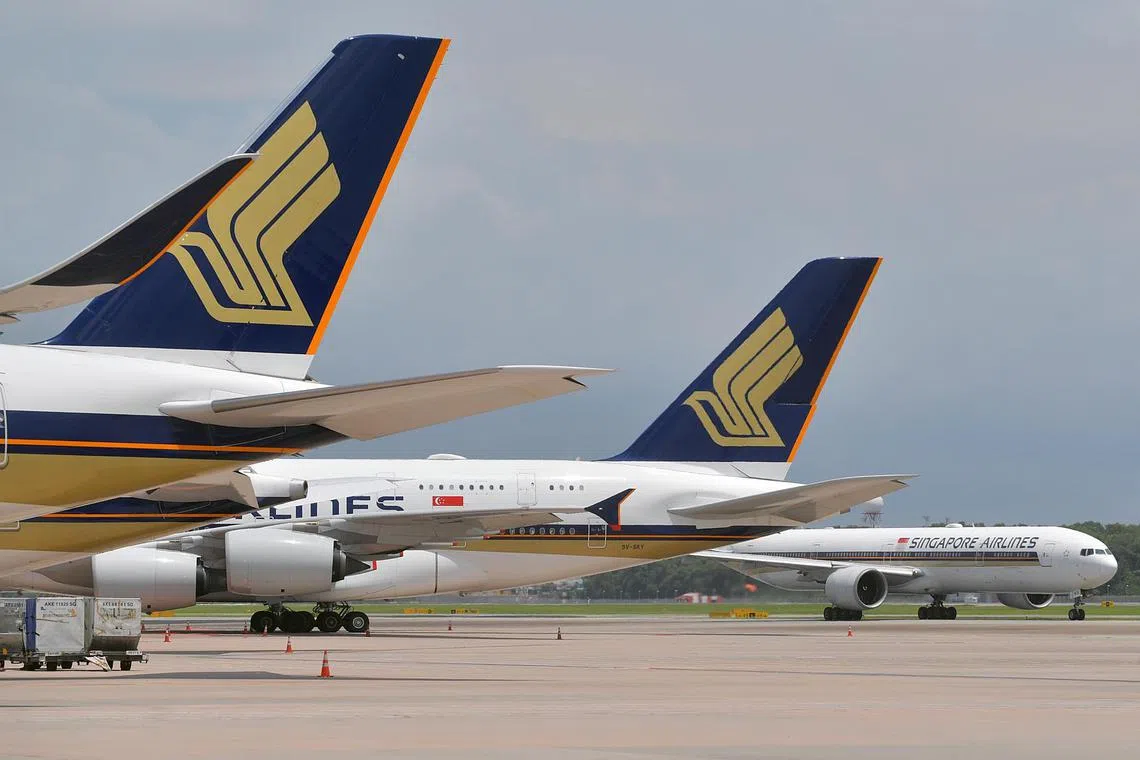SIA upbeat on outlook for current financial year amid strong post-pandemic recovery
Sign up now: Get ST's newsletters delivered to your inbox

SIA reported a record operating profit of $1.23 billion for the first half of the financial year ending Sept 30, 2022.
ST PHOTO: ALPHONSUS CHERN
Follow topic:
SINGAPORE - With five records broken in the six months ending Sept 30, Singapore Airlines remains predictably optimistic that it will end the current financial year on a high.
At a briefing on Monday morning, where the mood among senior officials seemed cheery for the first time in almost three years, chief executive Goh Choon Phong painted an upbeat picture of the airline’s operating conditions.
“We are recovering strongly from the Covid-19 era,” Mr Goh said. “Besides strong passenger ticket sales, we are also capturing cargo demand. Meanwhile, we are expanding our sales and marketing outreach, have revamped our premium lounges, and have started recruiting pilots and cabin crew.”
For the first half of the financial year ending Sept 30, the airline group reported a record operating profit of $1.23 billion. It also had a record operating profit of $678 million for the July-September quarter, record quarterly group passenger load factor of 86.6 per cent, record quarterly revenue per available seat kilometre of 10.3 cents, and record quarterly group revenue of $4.49 billion.
Net profit for the six months to end-September swung around by some $1.76 billion to $927 million, translating into earnings per share of 14.4 cents.
The company’s balance sheet was also much stronger, with shareholders’ equity at $23.2 billion and debt-equity ratio slipping to 0.68 by the end of September. Cash and bank balances increased by $3.7 billion to $17.45 billion.
The airline has reinstated dividend payment after almost three years,
The company, which raised some $22.4 billion between May 2020 (as the pandemic took hold) and January 2022, has announced its intention to redeem the first tranche of its mandatory convertible bonds.
On Oct 25, SIA said it intends to fully redeem the $3.496 billion mandatory convertible bonds which were issued on June 2020 on Dec 8 this year.
Fuel was its single biggest expense item, with the $1.89 billion or 233 per cent rise in fuel bill to $2.7 billion due to both higher uplifts (as a result of more flights) and rising prices. But it made a hedging gain of $365 million during the first half.
Executive vice-president for finance and strategy Tan Kai Ping said the company was hedged for 40 per cent of its needs for the remaining part of its current financial year and into the first quarter of the following financial year at an average price of US$60 per barrel.
After that, it has hedged up to 10 per cent of its fuel needs on a declining “wedge profile” at an average price of US$80 per barrel.
Mr Lee Lik Hsin, executive vice-president (commercial), said 2022 has been a unique year, with pent-up travel demand seeing seats quickly fill up all the way into the early part of 2023. Adding to leisure travel demand has been a strong pick-up in business travel since the middle of 2022.
Passenger yield rose 32 per cent year on year during the July-September 2022 quarter.
But Mr Lee said yields in 2023 could pull back as travel demand normalises and more capacity comes on-stream.
The group’s passenger capacity rose to an average of 68 per cent of pre-pandemic levels in the second quarter of FY2022/23 and is projected to reach an average of around 76 per cent in the third and fourth quarters of FY2022/23.
While not predicting any immediate change in China’s zero-Covid-19 policy, company officials acknowledged that travel demand could get a strong additional boost if and when the country reopens.
Analysts estimate that prior to Covid-19, China and north-east Asia accounted for about a fifth of SIA’s income.
Mr Lee said SIA was prepared to inject additional capacity if demand picked up sharply.
Cargo demand, which plateaued through the second quarter, could also get a lift if China reopens. SIA’s cargo load factor declined to 61.1 per cent during the first half, from 88.2 per cent a year earlier, as demand normalised and competition picked up.
The biggest challenge for SIA, and the aviation sector in general, next year are rising fuel prices and potential global recession, which could curtail travel demand, according to analysts.


